LIFE AND LABOR AT MONTICELLO
|
 The eighteenth century was a time
of extensive migration in Virginia as settlers in the Tidewater
pushed beyond the rivers to the West. In these western uplands,
called the Piedmont, the settlers replicated, as best they could,
the land use patterns, labor systems, and social structures they
had left behind. The Jefferson family, led by Thomas's father
Peter, was part of this western movement. At least three hallmarks
of Thomas Jefferson's character and interests date to this background:
his interest in western exploration and settlement; his belief
and participation in public service; and his lifelong adherence
to the plantation-slave system of agriculture.
The eighteenth century was a time
of extensive migration in Virginia as settlers in the Tidewater
pushed beyond the rivers to the West. In these western uplands,
called the Piedmont, the settlers replicated, as best they could,
the land use patterns, labor systems, and social structures they
had left behind. The Jefferson family, led by Thomas's father
Peter, was part of this western movement. At least three hallmarks
of Thomas Jefferson's character and interests date to this background:
his interest in western exploration and settlement; his belief
and participation in public service; and his lifelong adherence
to the plantation-slave system of agriculture.
Throughout his life at Monticello
and Poplar Forest, his country retreat, Thomas Jefferson sought
to create a classic example of the country gentleman's estate,
based on his personal experiences, his reading, and a broad network
of correspondence. Thomas Jefferson's world of books provided
him with opportunities throughout his life to experience other
aspects of the world and learn selectively from them to create
an idealized realm, sometimes untempered by the reality of life
experiences.
|
LIFE IN THE PIEDMONT
|
Fry and Jefferson map of Virginia
This is a second edition of a map originally drawn by Thomas
Jefferson's father, Peter (1707/08-1757), and Joshua Fry (1700-1754)
in 1751. This map includes Albemarle County, Virginia much the
way it was in Jefferson's youth. Shadwell, the Jefferson family
plantation, is indicated at the upper right. Peter Jefferson became
one of the first magistrates of the county when it was formed
in 1744. This upland expansion provided Virginia with much of
the dynamic energy found in the state's expanding political, geographic,
and economic life.
|
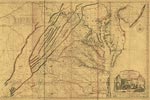
|
|

|
View from Monticello towards Charlottesville
Thomas Jefferson often used his telescope to study and enjoy the views over
the Piedmont from Monticello, which was built on the top of a
conical hill. Charlottesville was the site of the University of
Virginia, and Jefferson could watch the progress of its construction
without leaving his home. This view shows the fertile highlands
and small hills typical of the area, and the University of Virginia
can be seen under construction.
|
Thomas Jefferson acquires slaves, supplies, and services
During most of his life, Thomas Jefferson kept detailed records,
in books like this one, on his slaves, farms, and garden. He recorded
births, deaths, work assignments, and food and clothing allotments.
Jefferson also included minute observations and calculations about
the natural world; the work cycles at his plantations, mills,
and manufactories; and the work of his labor force.
|

|
|

|
Crop rotation plan for Monticello
Thomas Jefferson, like other enlightened farmers, took a scientific approach
to farming with the help of his son-in-law, Thomas Mann Randolph
(1768-1828), who managed much of Jefferson's land after marrying
Martha "Patsy" Jefferson in 1790. Jefferson's careful consideration
of a workable method of crop rotation for Monticello -- an innovative
practice at the time -- demonstrates his interest in scientific
farming.
|
Jefferson's larger family at work
In addition to their general labor, slaves contributed to Monticello
by selling fowl and vegetables from their own flocks and gardens
to the plantation masters. The plantation mistress or her daughters
made these purchases and maintained the household records. This
book had first been used by Jefferson for legal notes and then
by his wife, Martha (1748-1782), for her household records and
recipes. Jefferson's granddaughter, Anne Cary Randolph (1791-1826),
continued these records in the early nineteenth century. Most
of the purchases recorded were made from the house slaves, particularly
the extended Hemings family.
|

|
|
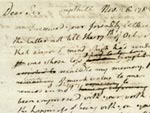
|
As dead to the world as she whose
loss occasioned it
Thomas Jefferson was devastated by the death of his wife Martha Wayles Skelton
Jefferson who died after giving birth to their sixth child, Lucy
Elizabeth (1782-1784). Jefferson wrote little about his wife's
death, making this entry into his account book on September 6,
1782: "My dear wife died this day at 11H -45' A.M." More than
two months later he haltingly wrote to a French officer and friend,
Marquis de Chastellux (1734-1788), that he was... "emerging from
the stupor of mind which had rendered me as dead to the world
as [she] was whose . . . loss occasioned it."
|
LIFE AT MONTICELLO
|
Jefferson's education plan
for his daughters
After the death of his wife, Jefferson carefully planned the
education and training of his daughters, Martha (1772-1836), Maria
(1778-1804), and Lucy (1782-1784). In this letter, he laid out
a plan of study for his daughter Martha, so that she would be
able to fulfill the social role of plantation mistress. Learning
the social graces of music, dancing, letter writing, as well as
knowledge of literature and language ability were skills that
he considered essential.
|
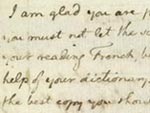
|
|

Lucy,
ca.1845.
Daguerreotype.
Courtesy of Mason County Museum,
Maysville, Kentucky (12)
|
Monticello's Lucy
Lucy (1811–?) daughter of Lilly and Barnaby, was born on Monticello
and was one of Thomas Jefferson's slaves sold at public auction
at Monticello in January 1827. Lucy and her parents were among
the slaves whom Jefferson leased to his grandson, Thomas Jefferson
Randolph (1792–1875). This photograph was taken of Lucy in the
mid 1840s.
|
Skills of slaves, inventory
in hand of James Hemings
James was a member of the Hemings family inherited by Jefferson
and his wife at the death of his father-in-law, John Wayles. James,
the son of Elizabeth Hemings and, most probably, Jefferson's father-in-law,
had been trained as a French chef. This was the final accounting
inventory of Monticello kitchen utensils and equipment prepared
and written by James Hemings (1765-1801), just two weeks after
Jefferson honored the written promise of freedom he had made to
James in 1793.
|

|
|

|
Thomas Jefferson sells slaves
to satisfy creditors
When his father-in-law, John Wayles (1715-1773) died, Jefferson,
through his wife, inherited the estate and the debts that came
with it. To settle the debts, Jefferson sold dozens of slaves.
In these letters to his brother and an overseer, Jefferson reveals
both his recognition of the property value of slaves and a human
concern and respect for the unity of a slave family.
|
Thomas Jefferson and Sally Hemings
In 1873, the Pike County Republican, ran a series
entitled, "Life Among the Lowly," Which included a memoir by Madison
Hemings, a resident of Ross County, Ohio. Hemings stated that
his mother Sally, who was the half-sister of Jefferson's wife,
Martha Wayles Skelton Jefferson and a slave of Thomas Jefferson,
gave birth to five children "and Jefferson was the father of them
all." Madison Hemings's statement has been contested for well
over a century. In January 2000, however, after completion of
a year's work by a research committee assessing the most recent
evidence including a 1998 DNA study, the Monticello/ Thomas Jefferson
Memorial Foundation, Inc, issued a statement stating that "the
best evidence available suggests the strong likelihood that Thomas
Jefferson and Sally Hemings had a relationship over time that
led to the birth of one, and perhaps all, of the known children
of Sally Hemings."
|

Madison Hemings.
"Life Among the Lowly, No. 1,"
Pike County Republican,
March 13, 1873.
Reproduction of newspaper article.
Courtesy of Ohio Historical
Society, Columbus (11) |
|
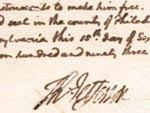
Thomas Jefferson.
Promise of Freedom,
September 15, 1793.
Reproduction of manuscript.
Courtesy of the Massachusetts
Historical Society, Boston (108) |
Promise of freedom for James Hemings
On September 15, 1793, while residing as secretary of state
in Pennsylvania, which had abolished slavery in 1780, Thomas Jefferson
promised to free his slave James Hemings, after James had trained
a replacement French chef. On February 5, 1796, Jefferson freed
James and provided money for his return to Philadelphia. Jefferson
manumitted or allowed to escape from bondage only ten slaves,
all members of the Hemings family, out of over six hundred he
owned over the course of his life. Five of those gained freedom
in his lifetime, five under the terms of his will.
|
View of Poplar Forest
Thomas Jefferson built his octagon house, in the Palladian style,
at Poplar Forest, a plantation inherited from his wife Martha's
father, John Wayles in 1773. Jefferson usually went to Poplar
Forest several times a year, staying for up to two months to oversee
plantation production and to avoid visitors at Monticello. Jefferson
left Poplar Forest to his grandson Francis Eppes (1801-1881),
who sold it two years later to a neighbor. The house remained
a private home until 1984.
|

Les Schofer.
View of Poplar Forest.
Color photograph.
Courtesy of the Corporation for
Jefferson's Poplar Forest (8c) |
|
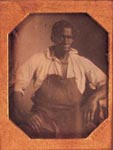
Isaac Jefferson,
1845.
Copyprint of daguerreotype.
Courtesy of the Tracey W. McGregor
Library of American History,
Special Collections Department,
University of Virginia Library, Charlottesville (16)
|
Isaac Jefferson
Isaac Jefferson, Thomas Jefferson's slave, was trained as a
tinsmith and nailmaker. He and his wife Iris and two children
were deeded to Jefferson's daughter Mary at the time of her marriage
in 1797. By 1798, Isaac was hired by Thomas Mann Randolph, who
was managing Monticello for his father-in-law Thomas Jefferson.
Though it is not clear how he came to do so, Isaac left Monticello
four years before Jefferson died, and later moved to Petersburg,
Virginia, where this photograph was taken when Isaac was seventy-years
old.
|
Thomas Jefferson's hair
Thomas Jefferson's hair cuttings were taken on Jefferson's deathbed
as keepsakes by his only surviving daughter, Martha Jefferson
Randolph, and other family members. Three samples came to the
Library of Congress in clearly identified envelopes with the papers
of Jefferson. Martha wrote on one envelope: "My dear father Thomas
Jefferson." The hair samples are cuttings without follicles and
therefore are useless for DNA studies. Only the Thomas Jefferson
Memorial Foundation is known to have custody of additional cuttings
of Jefferson's hair.
|
|
|
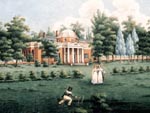
Jane Pitford Braddick Peticolas.
View of the West Front
of Monticello,
c. 1827.
Copyprint of watercolor on paper.
Courtesy of Monticello/Thomas Jefferson
Memorial Foundation, Inc. (8b) |
View of the west front of Monticello
Jane Pitford Braddick Peticolas painted Monticello for her friend,
Ellen Randolph Coolidge (1796-1876), Jefferson's granddaughter,
shortly after Jefferson's death. The painting portrays an idyllic
scene with various Jefferson descendants enjoying themselves.
No slaves are pictured, and perhaps they had all been sold when
this picture was painted. Jefferson's designs for Monticello were
based on the plans of the sixteenth-century Italian architect,
Andrea Palladio, and incorporated the latest French designs. The
intent was to create a little city in the country.
|
Reusable pocket notebook
Thomas Jefferson used these ivory sheets to make penciled notes,
which could then be erased once he transferred the information
into one of his numerous permanent record books.
|
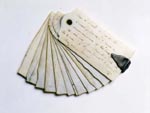
Ivory note pages
owned by
Thomas Jefferson.
Courtesy of Monticello, Thomas
Jefferson Memorial Foundation, Inc. (65)
|
|

|
Thread case of
Martha Wayles Skelton Jefferson
The thread case used by Thomas Jefferson's wife, Martha Jefferson
(1748-1782), is one of her few relics kept by Thomas Jefferson.
Martha's thread case and her household accounts for Monticello,
both in the collections of the Library of Congress, document the
economic and social role of the southern plantation mistress.
|
WORLD OF BOOKS
|
"The three greatest men that
have ever lived"
"Bacon, Locke and Newton" were "the three greatest men that
have ever lived, without any exception, and as having laid the
foundations of those superstructures which have been raised in
the Physical & Moral sciences." So states Thomas Jefferson
in this February 15, 1789, letter to John Trumbull, ordering copies
of portraits of the three men. Their work in the "Physical &
Moral sciences" was instrumental in Jefferson's education and
world view. For example, Bacon's divisions of knowledge became
Jefferson's divisions in his library catalog.
|

|
|

|
Jefferson's literary commonplace book
Thomas Jefferson began to maintain this literary commonplace
book while a schoolboy and continued the practice into the 1770s,
displaying his wide-ranging literary interests. He was a great
admirer of the classical writers, particularly Marcus Tullius
Cicero (106-43 BC). Jefferson's entry, as shown here, was taken
from Laurence Sterne's Tristram Shandy. Jefferson
and his wife, Martha, recopied this passage on her death bed.
|
"I cannot live without books."
On hearing of the sale of Thomas Jefferson's library to Congress
as a replacement for the books burned by the British in August
1814, John Adams wrote to Jefferson on October 28, 1814: "By the
Way I envy you that immortal honour: but I cannot enter into competition
with you for my books are not half the number of yours." Jefferson
did not reply to Adams' letter until June 10, 1815, but wrote
"I cannot live without books, but fewer will suffice where amusement,
and not use, is the only future object."
|

|
|

Memoirs of a Monticello slave,
Isaac Jefferson, as dictated to
Charles Campbell, 1847.
Reproduction.
Courtesy of Tracy W. McGregor Library
of American History,
Special Collections Department
University of Virginia Library (17)
|
"Old Master had abundance of books"
Issac Jefferson (1775-c.1849), described Jefferson's reading
habits: "Old Master had abundance of books; sometimes would have
twenty of 'em down on the floor at once-read fust one, then tother."
Trained as a tinsmith and nailmaker while a slave of Thomas Jefferson,
Isaac related this information as part of an oral history given
to Charles Campbell in 1847.
|
Jefferson was an avid newspaper reader
Though Thomas Jefferson made conflicting statements about the
American press, he was an avid reader of newspapers. The
Genius of Liberty was just one of more than 70 newspaper
titles represented in Jefferson's library when it was sold to
the Congress in 1815. Jefferson's newspapers were nearly all destroyed
in the fire of December 24, 1851. Jefferson also maintained newspaper
clipping files and often wrote a subject notations in the margin.
|

|
|

|
Revolving five-sided book stand probably designed by Jefferson
This cube-shaped book stand was probably designed by Thomas
Jefferson to hold five books and allow the reader to rotate the
stand, thus changing the book in view. The solid walnut stand,
designed to sit on a tripod was made at the Monticello joinery,
supervised by James Dinsmore and John Hemings.
|
Jefferson's favorite copying machine
Thomas Jefferson, who wrote tens of thousands of letters used
the polygraph machine, invented by an Englishman John Isaac Hawkins
(1772 1855) and produced in America by Charles Willson Peale (1741
1827) to produce copies for himself, as well as his correspondent.
Jefferson provided Peale with many suggested improvements to the
delicate mechanism, which Peale tried to incorporate in the machine.
Jefferson used the machine from 1804 until his death. It is nearly
impossible to determine which copy of the page was made by the
pen held by Jefferson or the off-pen.
|
|
Library of Congress Exhibitions -
Online Survey -
Library of Congress Home Page
|

